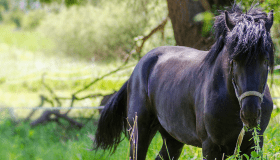
April 21, 2022 — For many horse owners, sounds like whinnying, snorting and squeals are important clues to determine how their horses are feeling. But there’s another part to horse communication that is equally as important and which can be subtler and harder to interpret at first. That’s horse behavior.
Horses have a wide range of body language and behaviors to tell us if they are having a good day or a bad day; if they are stressed or not feeling well. In the equine research world, a growing awareness is evolving concerning the link between behavior and a horse’s well-being, but there is still much work to do.
Dr. Wendy Koch, a veterinarian and horse lover, was discouraged when she tried to learn more and found almost no research projects focused on behavior issues affecting horses. She decided to do something about it. Dr. Koch reached out to Morris Animal Foundation and together created a special fund for Equine Behavior/Welfare Research.
The fund supports studies that improve the understanding of equid behavioral and psychological needs and challenges, including five new equine behavior studies:
Behavior educational tools
Can teaching horse owners to better recognize different emotional states (affective states) in horses lead to improved welfare? Researchers are developing online training tools to help horse owners recognize and interpret horse behavior, emotions and body language that may be indicative of health or welfare issues in their animals.
Effect of touch in human-horse interactions
Studies show people react favorably to petting and interacting with animals, including horses, and how this interaction can boost human health and well-being. But what do we know about the horse’s point of view? Researchers are measuring stress in horses involved in human interactions, specifically to inform best practice guidelines for therapy horses. Their hope is to find ways to alleviate stress and improve the experience for the horse, as well as strengthen relationships between humans and horses.
Feeding Strategies
Researchers suspect some behavior issues in horses are due to caretakers having disrupted natural grazing behavior. Researchers are evaluating three feeding systems, specifically looking at the availability of roughage. New information will inform feeding management strategies to reduce abnormal behaviors in horses kept in dry lots.
Mare stress during weaning time
While studies show artificial weaning can be stressful for foals, little is known about how artificial weaning affects mares. Researchers are studying how mare life-history factors, including age and number of previous foals, as well as mare level of attachment to her own foal, affect stress-relevant behaviors at weaning.
Impact of light on stabled horses
Little is known about how variations in lighting interfere with sleep-wake cycles of stabled horses. Does lighting impact their sleep quality and, in turn, their overall health and behavior? Researchers are studying the effect of different types of indoor lighting on the behavior and well-being of stabled horses.
Additional Foundation-funded behavior equid studies include validating a pain assessment tool for recognizing and monitoring signs of chronic osteoarthritis pain in horses, defining behavioral signs of pain in mules, and establishing assessment tools for distinguishing between broken (well-handled) and unbroken (unhandled) horses to improve the welfare of unbroken horses during transport.
We’re excited about our new horse behavior studies and can’t wait to see what our scientific teams learn, and how to translate their research into real world strategies to help horses – and related equid species – everywhere!




